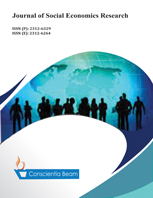Exploring the relationship between financial development and economic growth in ASEAN-5 countries and Vietnam
DOI:
https://doi.org/10.18488/35.v11i3.3936Abstract
This study examines the impact of financial development on economic growth in ASEAN-5 countries and Vietnam from 2000 to 2021, using panel data and employing OLS, FEM, and REM models. The urgent need for financial development is critical to ensuring international integration and enhancing Vietnam’s economic development. The independent variables considered include Broad Money Growth (BMG), the capital requirement for the private sector (CLP), Domestic Credit provided by the Banking sector (DCB), and financial market price indicators (INF), and their effects on economic growth (GDP). The findings indicate that financial development significantly influences economic growth, with impacts ranging from 13% to 37%. The private sector’s capital demand alone accounts for 37% of economic growth in these countries. This study underscores the positive relationship between financial development and economic growth, where financial development stimulates growth. The practical implications include recommendations for financial policies to promote integration and economic growth in developing countries. These findings provide empirical evidence supporting the necessity of careful financial system management to ensure sustained economic development. Furthermore, this research offers valuable insights for policymakers in the region, emphasizing the need for strategic financial reforms and innovations to foster long-term economic stability and growth.

